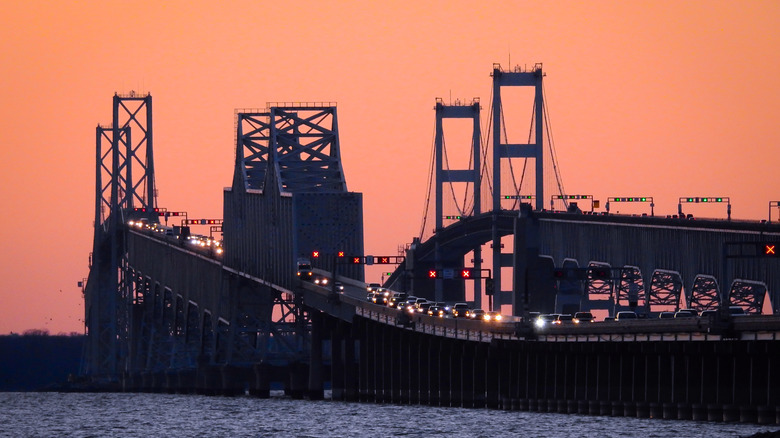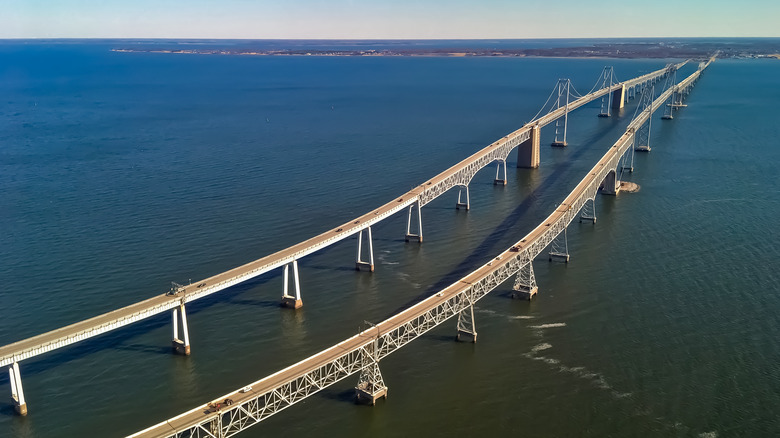The Chesapeake Bay Bridge in Maryland is a true engineering marvel. Officially named the Gov. William Preston Lane Jr. Memorial Bridge after the state governor who finally got the colossal construction project in motion in 1947 after many years of delays, it spans 4.3 miles of open water and connects Sandy Point on the western shore to Stevensville on the eastern side.
When the original bridge was opened in 1952, it was the longest continuous steel structure over water in the world and the third-longest bridge on the planet. A second parallel bridge was finished in 1973, and the logistics of the project were immense. Engineers bored up to 257 feet beneath the surface of the Bay to find sand firm enough to support the vast weight of the first bridge’s pilings, and the two spans used over 126,000 tons of steel and 286,000 cubic yards of concrete.
Of the two, the westbound span is the taller, with a suspension tower soaring to 379 feet above water level and the carriageway ascending to a hair-raising 200 feet in the air. By comparison, the older eastbound crossing only ascends to a height of 186 feet. Nowadays, it only looks like a short hop across a mill pond compared to modern mega-structures like the 102-mile-long Danyang-Kunshan Grand Bridge in China, but that exhilarating commute over the Chesapeake Bay is still a journey across one of the most terrifying bridges in the world.
Why are people so scared of the Chesapeake Bay Bridge?

The Bay Bridge has developed a fearsome reputation as one of the world’s scariest bridges. For many nervous drivers who feel apprehensive about crossing the Chesapeake Bay Bridge, the older eastbound span causes the most terror. On the ascent to the bridge’s highest point, a curve in the road creates the illusion that you are about to drive off the edge into thin air. The low barriers are not solid, allowing you to see into the distance and the water far below. This can play havoc with people who suffer from a fear of heights. Another factor is the lack of a hard shoulder on the carriageway, so there is no place to stop once you’re on the bridge.
Bad weather on the Bay Bridge can also be scary. Out in the middle of the water, the highest sections are exposed to the elements and are often hit by storms. In heavy conditions, visibility is so poor that land is out of sight. Fear of the bridge is so common that some drivers are willing to pay up to $40 for a drive-over service to take the wheel on their behalf. Companies like Kent Island Express pride themselves in helping customers relax and claim that some passengers have even asked if they can travel in the trunk for safety!
Is there any real reason to fear the Bay Bridge?

Around 60,000 vehicles cross the Chesapeake Bay Bridge every day and motor accidents are an inevitable occurrence. It’s something we all fear, but the idea can be even more scary when you’re driving with only a single steel barrier to prevent you from plummeting into the water far below. Accidents like this are rare but do sometimes happen: A woman survived a plunge into the bay in 2013, escaping through a broken window and swimming to safety.
Weather can also play a factor in traffic accidents on the bridge. In January 2024, witnesses described a “wall of fog” (per The Washington Post) before a 43-car pile-up. Yet despite its reputation for being dangerous in storms and high winds, the Bridge is rarely closed due to extreme conditions. One such occasion was in January 2024, when authorities halted traffic for several hours as high winds reached 55 mph.
After the catastrophic collapse of Baltimore’s Key Bridge in March 2024, concerns were also raised that the Bay Bridge could face a similar fate if it was also struck by a cargo vessel. Located 20 miles downstream on the same shipping route, its aging pilings are surrounded by wooden barriers that would do little to protect them from a huge container ship like the one that brought down Key Bridge. While there are dangers present, it is still one of the most thrilling roads to cruise down before you die.

